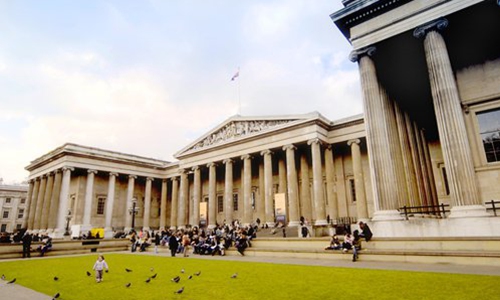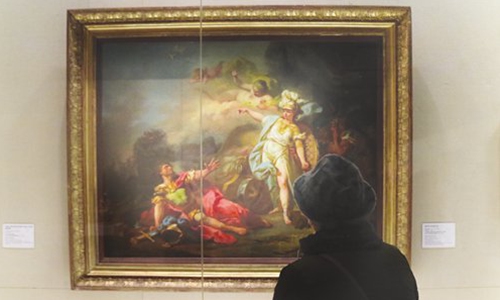HOME >> ARTS
Will livestreaming open a door to China for Western museums?
By Bi Mengying Source:Global Times Published: 2020/2/17 18:04:37

The British Museum Photo: VCG
Even though many Chinese people are still staying at home and not traveling abroad due to the outbreak of the novel coronavirus pneumonia, a tour at the British Museum still managed to attract more than 2 million Chinese visitors on Saturday.
This wasn't due to some spike in travel from China. In this case, the visitors were still safely at home, tuning in to a 90-minute livestream about the British Museum on Kuaishou, a popular short video platform in China. The first livestream on the platform's "Museums are Fun" channel, the stream quickly garnered more than 500,000 likes.
"We hope to bring a larger world to people who are staying at home," Kuaishou representative Li Tuo told the Global Times on Monday.
"Because of the novel coronavirus epidemic, students are studying at home and people are working from home. So we want to take the opportunity by combining the technological advantage of Kuaishou with the rich cultural resources of museums and open a window to the beauty and education of museums for people. It will be a novel educational approach for all, but especially the children and the young."
Increasing eagerness for knowledge
Chang Ji, 43, was the host of the popular livestream. A Chinese who has been living in the UK for nearly 20 years, he has worked as a freelance docent for about a decade. Chang had already been working in the tourism business before focusing on museum tours, which he has noticed have come into increasing demand over the past decade. Take the team that Chang has been working together with for example. They started out as three freelance docents and now the team has expanded to more than 40 members.
Accompanying the increasing popularity of museums among Chinese tourists has been increased efforts from Western museums to grow brands in China and attract tourists back to museums. The National Gallery in London has launched a couple of projects and pop-ups in different Chinese cities such as Shanghai in East China and South China's Guangzhou.
Meanwhile, the British Museum opened an online store on e-commerce platform Tmall under Alibaba in July 2018. With close to 1.2 million followers, its online store carries a wide selection of souvenirs and products inspired by the popular collections from the museum. The first batch of products sold out within 16 days.
"The British Museum is a museum of the world, for the world," the museum's merchandising and licensing manager Craig Bendle told the media when talking about the store. He said he considers it as a channel to share the museum since not everyone has the opportunity to visit London in person.

A woman views The Combat of Mars and Minerva at the Louvre exhibition in the National Museum of China on Friday. Photo: Huang Tingting/GT
A wider reach
Chang, who often calls himself a storyteller, has also long been committed to sharing knowledge about museums and evoking people's curiosity for history. He was gladly surprised by the wide reach of his livestream on Saturday.
"By my estimate, I probably have had 20,000 to 30,000 customers at most while working a docent for face-to-face guided tours. So I was surprised by the unexpectedly large number of viewers on the livestream," he said.
"I'm doing this business [freelance docent] mainly out of passion. I hope more people can and are willing to learn about the stories and history of the collections at museums… In a sense, it is my way to pass along positive energy," he added.
Chang noted that while the questions from livestream viewers were similar to those raised by visitors who have taken their tours at the museums, one comment from a livestream viewer left a deep impression on him. Judging by the tone of it, it may have been a parent: "I don't usually encourage my child to use short video apps like Kuaishou and TikTok, but after watching this livestream, I asked my child to download the app instantly."
"I was touched. It was like I made a difference," said Chang.
A touch of fun
Since the outbreak of the novel coronavirus epidemic, museums across the country have been stepping up efforts to promote virtual tours and launching new online exhibitions on various online platforms such as their own official websites, WeChat, Sina Weibo and also short video apps like Kuaishou and TikTok.
Media and bloggers are also including information regarding international museums and art institutions that provide online tours such as the Louvre Museum in Paris and the Met in New York in their reports and articles as the virus epidemic continues keeping people indoors.
While their hearts are in the right place, the majority of the online exhibitions and virtual tours are confined to text explanations, photos, audio guides and short videos.
"It may be a bit rudimentary, it was like reading the museum labels," commented Chang, who tried his best to include fun facts, anecdotes, and the stories behind the items on display and interact more with the viewers of his livestream.
Chang is the first person in his team to host a museum tour livestream. After this successful experiment, many of his peers expressed an interest in doing their own tours as well.
Will livestreaming be another way for Western museums to grow their brands in China, allowing Chinese viewers to benefit from the knowledge of history and arts? That is a collaboration worth looking forward to.
Posted in: CULTURE & LEISURE